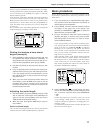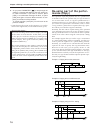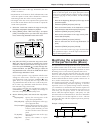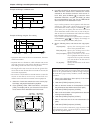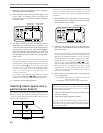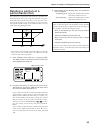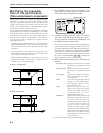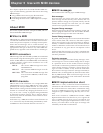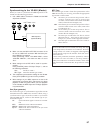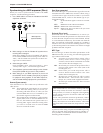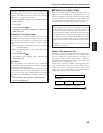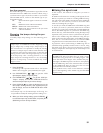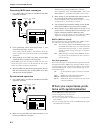
This chapter explains how the VS-880 handles MIDI mes-
sages, and the following operations that can be done using
MIDI messages.
● Using a MIDI sound source to play the metronome
● Synchronized operation with a MIDI sequencer
● Controlling the mixer from a MIDI sequencer (Compu-
mix)
About MIDI
This section explains the basic concepts of MIDI, and how
the VS-880 handles MIDI messages.
■ What is MIDI
MIDI stands for ÒMusical Instrument Digital Interface.Ó It is
a worldwide standard that allows electronic musical instru-
ments and personal computer to exchange musical perfor-
mance data and messages such as sound selections. Any
MIDI-compatible device can transmit musical data (as
appropriate for the type of device) to any other MIDI-com-
patible device, regardless of its manufacturer or model type.
■ MIDI connectors
MIDI messages (the data handled by MIDI) are transmitted
and received using the following three types of connectors.
On the VS-880, MIDI OUT and MIDI THRU are handled by
a single connector, which can be switched to act as the
desired connector. (p.90)
MIDI IN: This receives MIDI messages from exter-
nal MIDI devices.
MIDI OUT: This transmits MIDI messages from the
VS-880.
MIDI THRU: This re-transmits all MIDI messages that
were received at MIDI IN, without modi-
fying them.
■ MIDI channels
MIDI is able to send information over a single MIDI cable
independently to two or more MIDI devices. This is made
possible by the concept of MIDI channels. You can think of
MIDI channels as being somewhat similar in function to the
channels on a television. By changing the channel of a TV
set, you can view a variety of programs being transmitted
by different broadcast stations. This is because data is
received only from the transmitter whose channel is select-
ed on the receiver.
In the same way, a MIDI device whose receive channel is set
to Ò1Ó will receive only the data being transmitted by anoth-
er MIDI device whose transmit channel is also set to Ò1.Ó
■ MIDI messages
The VS-880 uses the following types of MIDI message.
Note messages
These messages are used to play notes. On a keyboard,
these message transmit the key (note number) that was
pressed, and how strongly it was pressed (velocity). On the
VS-880, these messages are used when you use a MIDI
sound source to play the metronome sound.
Program Change messages
These messages are for the purpose of selecting sounds, and
contain a program number of 1Ð128. The VS-880 V-XPAND-
ED uses these messages to select scenes and effects.
Control Change messages
In general, these messages are used to transmit information
such as vibrato, hold, and volume etc., that makes a perfor-
mance more expressive. The various functions are differen-
tiated by a controller number from 0Ð127, and the controller
number is defined for each function. The functions that can
be controlled on any given device will depend on that
device.
On the VS-880, these messages are used in a completely dif-
ferent way than on most instruments; they are used to con-
trol mixer parameters.
Exclusive messages
Unlike note messages and control change messages, exclu-
sive messages are used to transmit settings that are unique
to a particular device. On the VS-880, exclusive messages
can be used to control mixer parameters (in the same way as
control change messages). Normally, control change mes-
sages are easier to handle, so they should be used rather
than exclusive messages. Exclusive messages intended for
different units are distinguished by their Device ID, rather
than by MIDI channel. When exclusive messages are to be
transmitted or received, you must set the Device ID of both
units to a matching setting.
■ MIDI implementation chart
MIDI allows a variety of electronic musical instruments to
communicate with each other. However it is not necessarily
the case that all devices will be able to communicate using
all types of MIDI message. They can only communicate
using those types of MIDI message that they have in com-
mon.
Each ownerÕs manual for a MIDI device includes a MIDI
Implementation Chart. This chart shows you at a glance the
types of MIDI message that can be transmitted and
received. By comparing the implementation charts of two
devices, you will be able to see the types of message with
which they will be able to communicate.
Chapter 5 Use with MIDI devices
85
Chapter 5



